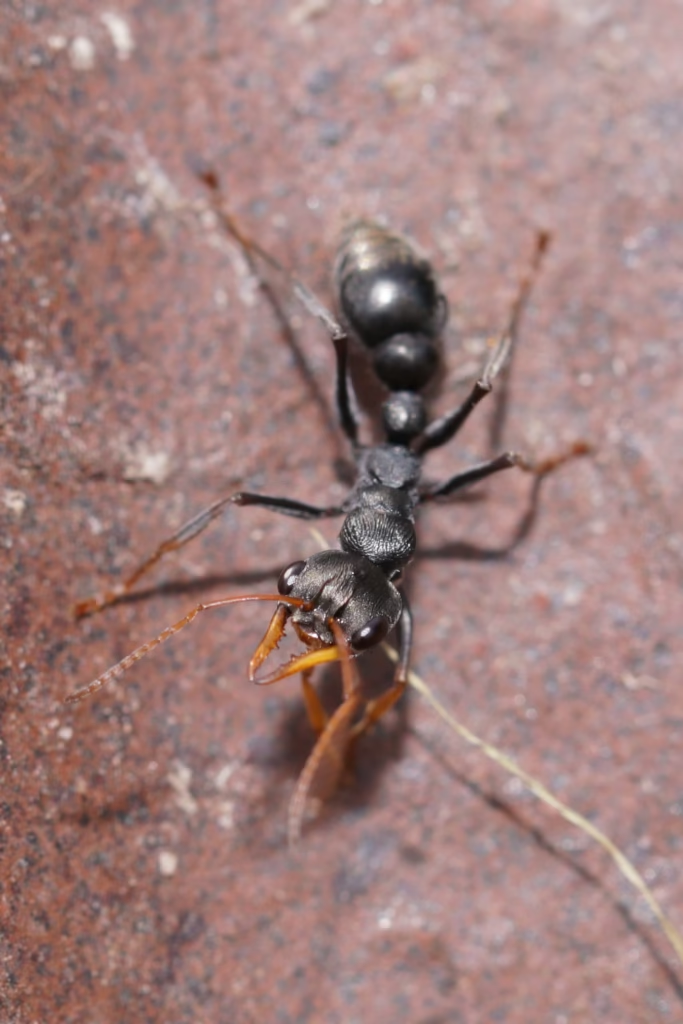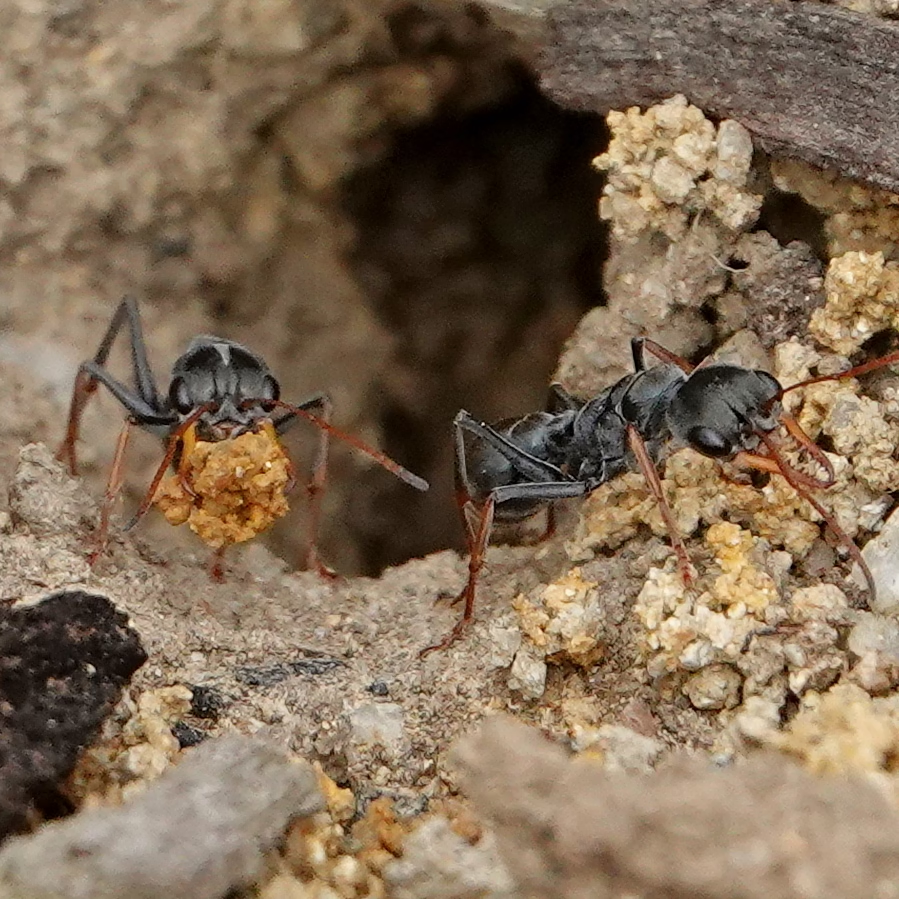Ant Species Guide / 11/02/2025 / Leave a Comment
| Scientific Name | Myrmecia pilosula |
| Common Name | Jumping Jack Ant (Jack Jumper) |
| Size | Workers: 10–14 mm | Queens: 14–16 mm |
| Lifespan | Queens ~10+ years | Workers ~1 year |
| Colony Type | Monogynous (Single Queen) |
| Foraging Activity | Diurnal (day-active); highly visual hunters |
| Natural Habitat | Open forests, woodlands, and grasslands across southern & eastern Australia |
| Nuptial Flight Season | Spring to early summer (Oct–Dec), late afternoon–evening |
| Hibernation | No true hibernation; reduced activity in cooler months |
| Founding Type | Semi-claustral – queen requires feeding during founding |

1. Introduction to Jumping Jack Ants
The Jumping Jack Ant (Myrmecia pilosula) is one of Australia’s most iconic native ants. They’re famous for a powerful sting, bold temperament, and that signature “jump” when startled—hence the name. Unlike many ants, Jumping Jacks rely more on vision than pheromone trails, making them exceptional day-active hunters. Their highly active behaviour and striking black-with-orange highlights make them fascinating—but best suited to experienced ant keepers.
⚠️ Safety warning: Jack Jumpers have clinically significant venom. In Tasmania, their sting causes more anaphylaxis cases than bees; approximately 3% of Tasmanians are allergic. Handle with extreme care and do not keep if anyone in the household has insect-sting allergy risk. Tasmanian Dept. of Health info.
2. Natural Habitat and Distribution
Jumping Jack Ants are widely distributed across southern and eastern Australia, especially Tasmania, Victoria, South Australia, and parts of New South Wales. Typical sites include:
- Forests & Woodlands – Nests at the base of trees, under logs, or in soil
- Grasslands & Bushlands – Dry, open areas with sandy or loose soil
- Urban edges – Occasionally in gardens and nature reserves
Nesting preferences:
- Subterranean burrows with multiple chambers
- Loose, sandy soil for easier excavation
- Sunny, open aspects; avoids shaded, wet locations
📖 External resource: species overview on AntWiki.
🔗 Related Guide: How to Find Queen Ants in Australia
3. Nuptial Flights – When and Where to Catch a Queen
Catching a Jumping Jack queen requires quick reflexes—they’re fast and alert.
When do they fly?
- Peak season: Spring to early summer (October–December)
- Weather: Warm, humid days following rainfall
- Time of day: Late afternoon to early evening (4 pm – 8 pm)
How to identify a queen:
- Larger size: ~14–16 mm, much bigger than workers
- Thicker thorax from flight muscles
- Fast-moving & solitary; runs across open ground searching for nest sites
🔗 Related Guide: What to Do with a Queen Ant After Capture
4. Founding Stage – Test Tube Setup
Jumping Jack queens are semi-claustral, so they must be fed during founding. Many keepers prefer a tub-and-tube or small nest with an attached outworld rather than a tight, fully sealed test tube—this reduces stress and allows safer feeding.
Founding setup:
- Tube size: 20 mm+ (glass or plastic)
- Water reservoir: ~1/3 full, sealed with cotton
- Cotton plug for airflow and escape prevention
- Feeding: small insects or honey water every few days
- Storage: dark, undisturbed, 24–28 °C
When to move: Transfer once there are at least 15–20 workers.
🔗 Related Guide: The Perfect Test Tube Setup for Queen Ants
5. Jumping Jack Ant Care – Housing & Nesting Requirements
These ants need space and a very secure setup due to their speed, jump ability, and aggression.
Best nest types:
- Acrylic nests – excellent visibility; provide deeper chambers for larger ants
- 3D-printed nests – customisable and expandable
- Ytong (aerated concrete) – holds moisture, reducing dehydration
- Large naturalistic setups – ideal for long-term colony growth and behaviour
🚨 Warning: Jumping Jacks jump and climb extremely well. Use PTFE barriers and tight-fitting lids to prevent escapes.
🔗 Related Guide: Moving Your Queen Ant to a Formicarium
6. Jumping Jack Ant Care – Feeding & Diet
Jumping Jacks are active predators and strongly prefer live prey, but will accept sugars for energy.
Best foods:
- Live prey (essential): crickets, mealworms, flies, small roaches
- Sugars: honey water, sugar water, fresh fruit
- Occasional treats: very small pieces of cooked chicken or fish
Feeding frequency: Offer protein every 2–3 days and always provide a sugar source; remove leftovers to prevent mould.
🔗 Related Guide: The Ultimate Ant Feeding Guide
7. Seasonal Dormancy & Hibernation
No true hibernation, but activity slows in winter.
- Dormancy period: May–August
- Temperature: 18–20 °C
- Feeding: Reduce frequency; always provide fresh water
8. Common Problems & Troubleshooting
Problem: Queen isn’t laying eggs
- Too much disturbance – check only every 1–2 weeks
- Temperature too low – keep 24–28 °C
- Infertile queen – if only males appear, mating was unsuccessful
🔗 Related Guide: How to Keep Your Ants Safe from Mites and Pests
Final Thoughts
Jumping Jack Ant care (Myrmecia pilosula) offers high-energy activity and fascinating predatory behaviour for advanced keepers willing to manage risk, space, and security. With robust escape-proofing and careful feeding, they’re one of the most impressive Australian species to observe.
✅ Great for advanced keepers
❌ Not recommended for beginners due to venom potency
Would you keep Jumping Jack Ants? Let us know in the comments!

